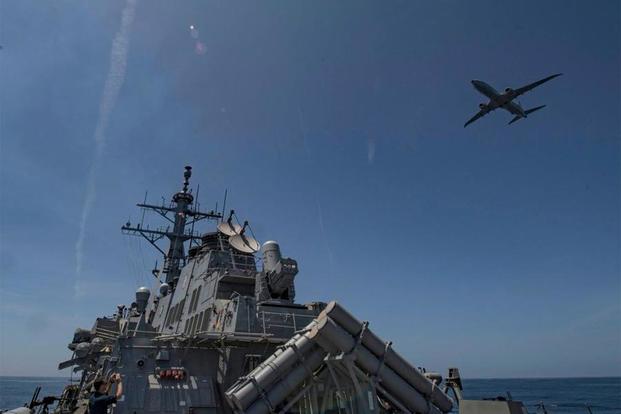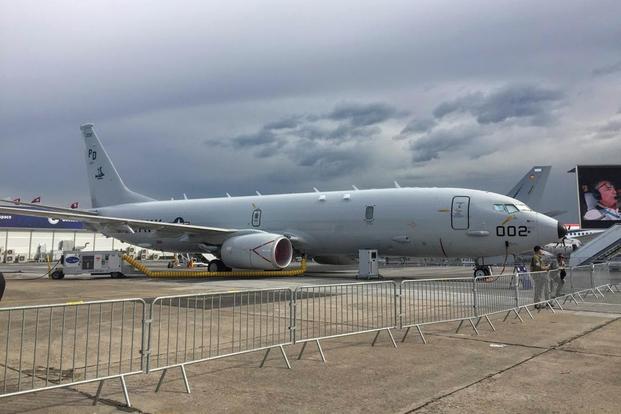SALON DU BOURGET, PARIS -- Last week, Iran's shootdown of a Navy RQ-4 Global Hawk drone made the headlines. But the Navy's P-8A Poseidon, a modified Boeing 737-800 specially designed for surveillance that typically carries a crew of nine, was also in the sky watching events unfold.
Iranian leaders said they refrained from shooting down a P-8 transiting in the region, and instead shot down the Global Hawk June 19, claiming the drone violated its airspace. U.S. Central Command officials said neither the RQ-4 nor P-8 entered Iranian airspace that day, but added that U.S. aircraft routinely operate in the region.
The P-8 was nearby when the drone was downed, and captured photos of the incident, CENTCOM officials said Friday. If the Iranians had opted to shoot down a manned aircraft, it likely would’ve raised the stakes as tensions with the U.S. continue to grow.
It's not the first time a P-8 has made headlines. Earlier this month, a P-8 was also dispatched to assess the damage two tankers sustained in the Gulf of Oman amid the Iran dispute. The sub-hunter aircraft, which is also used for search and rescue, anti-surface warfare and shipping interdiction, has also been intercepted more than a handful of times by Russian fighters while on missions in the Baltic and Black Seas over the last three years.
In 2015, the U.S. released audio of the Chinese navy asking a U.S. P-8 in the South China Sea to "please go away quickly!" In 2014, a pair of P-8s was launched to aid in search for Malaysia Airlines flight MH370.
Related content:
- US Denounces 'Unprovoked Attack' After Iran Shoots Down High-Value Navy Drone
- Iran Chose To Take Out Drone Instead of Manned Navy Jet, lranian General Says
- P-8A Poseidon | Military.com
At first glance, the Poseidon doesn't stand out like a F-14 Tomcat or other fighter aircraft might. Yet the spy aircraft has a vital mission, especially as hotspots around the world continue flaring up.
Members of the Patrol Squadron 9 "Golden Eagles," who had a P-8 on display at the Paris Air Show last week, said the relatively new plane, which deployed for the first time in 2013, has given crews significant flight and surveillance upgrades. They spend less time "fighting the aircraft," they say, than they did with the P-8's predecessor, the P-3C Orion.
"We spend more time getting the missions done," Navy Lt. Caleb Gerard told Military.com last week. Gerard, who has served five years in the Navy, transitioned to flying the P-8 from the almost-60-year-old P-3 about a year ago.
"The automation that comes with flying a new aircraft ... has a very positive impact,” he said, adding that he can focus more on tactics during missions than the plane’s systems before giving reporters a peek inside the aircraft.
Always on Track
The Navy sent its first P-8 patrol squadron to Naval Air Station Sigonella, Italy, in April.
The P-8's main mission is to track submarines by dropping buoys that ping, listen and detect. A handful of cylindrical cases in the very rear of the plane carry 129 buoys. The crew decides which it will drop based on weather and altitude, and they then monitor the data they collect.
The P-8 also uses a mix of sophisticated GPS systems, radios, electronic warfare tools, communication nodes, infrared imaging and high-tech radars to detect things happening on or below the water’s surface. Its lightweight AN/APY-10 radar, nestled within its "snoopy nose," can detect and classify threats at long ranges.
The aircraft’s systems then collect and display that data for the crews, much like the Air Force's "family of systems" approach.
And it can cruise: While the P-8 often flies at high altitudes to keep an eye over the vast ocean, it can almost skate over the water at altitudes as low as 200 feet above sea-level, which the crew here says is impressive.
Flying that low allows them to zero in on a sub or lob an MK-54 torpedo or AGM-84D Harpoon missile, said Lt. Adam Anderson, a tactical coordinator, or TACCO.
The plane carries the missiles on its external wing pylons or in the weapons bay on the underside of the aircraft, he said. Anderson has fired both the Harpoon and torpedo weapons, but only during tests.
Navy officials are already looking at other weapons they can add to the platform. Earlier this year, Boeing Co. received a $9.2 million contract to begin integration work for the High Altitude Anti-Submarine Warfare Weapon Capability, or HAAWC, which would give the P-8 increased standoff range.
With the enhanced specs, the Navy and allies may want more.
"The P-8 Poseidon is the maritime patrol aircraft and reconnaissance aircraft for today and for the future," said Navy Captain Tony Rossi, program manager for the maritime patrol and reconnaissance aircraft. In a statement provided to reporters, he said there are "several other potential [foreign military sales] cases as well as additional U.S. Navy quantities in the works."
"I think there'll likely be additional U.S. orders and [foreign military sales] quantities in the next six to nine months," Rossi told Reuters in June. "... The time to join the program is now."
Expanding Worldwide
The P-8's value has been noticed, especially by countries with large maritime forces.
In 2016, Norway, for example, agreed to purchase five of the Boeing-made aircraft by 2023, a move some there say is necessary.
"They'd be mad not to," a former Norwegian P-3 Orion flight officer said during Military.com's recent trip to the near-Arctic region last month. Norway's pursuit of a P-3 replacement comes as officials there observe an uptick in Russian sub and underwater drone activity.
The ex-flight officer explained that submarines coming from the Barents Sea -- where Russia keeps its submarine hub near the Kola Peninsula -- can be tracked, but tend to "slip away" through the Greenland, Iceland, U.K. waterways, nicknamed "the GIUK."
"We've built over 100 [P-8s] now," said Fred Smith, director of business development for mobility, surveillance and engagement for Boeing.
Smith said roughly 85 belong to the U.S. The others are with India and Australia. The countries on contract to receive purchased P-8s in the future include the United Kingdom, Norway, New Zealand and South Korea.
Countries may want to buy in knowing that the aircraft will consistently receive upgrades to make it more capable for future surveillance missions, Smith said.
"We think that anybody who flies a large maritime patrol aircraft is still in the market," Smith said. "Those are aging out, they're going to become cost prohibitive to sustain them as a single-type model series with their own software, it's going to be expensive."
Teaming Inside and Out
The aircraft was also developed "with manned-unmanned teaming in mind," Smith said.
The Navy will use the Broad Area Maritime Surveillance (BAMS) program that will use drones such as the MQ-4C Triton to pass and exchange information with P-8s for fine-tuned intelligence gathering.
"The concept has always been a partnership between P-8 and BAMS ... to provide targeting and queueing, and the P-8 is the more tactical asset," Smith said.
Unlike the P-3, the U.S. P-8 does not have a magnetic anomaly detector (MAD) boom, which can detect metal hulls of subs. India's P-8s use a MAD boom.
"The U.S. Navy is moving to high-altitude anti-submarine warfare," Smith said. "It's just dependent on what the operational concept of each country is."
Smith said there are futuristic concepts being discussed for MAD detection, which may not require a boom on the back of the aircraft.
MAD or no MAD, tracking subs involves the entire crew to watch and listen, Anderson said.
But the process has been completely transformed with the "media driven, not hardware driven" software which allows the acoustic operators, TACCO, Co-TACCO, the radar navigators, and even the pilots to work as a team to steer in the right direction to keep an eye on their target, Anderson said.
"The system is more intelligent," Anderson said. As a TACCO, he can control the copious amounts of settings and filters on one of the P-8's six inner consoles to designate plot points. He can even send the same wide-area map he's looking at up to the cockpit, because the cockpit's mission system display can switch to showing what the operators see.
Because of its modern enhancements, the crews can fly further, and stay on station longer, Gerard said, meaning they can stay on base an extra hour or two instead of getting airborne earlier for a mission.
"We have the ability to add to this aircraft," Gerard said. "We have the ability to do multiple mission sets, and I think that that is a huge benefit to the P-8."
-- Oriana Pawlyk can be reached at oriana.pawlyk@military.com. Follow her on Twitter at @oriana0214.















